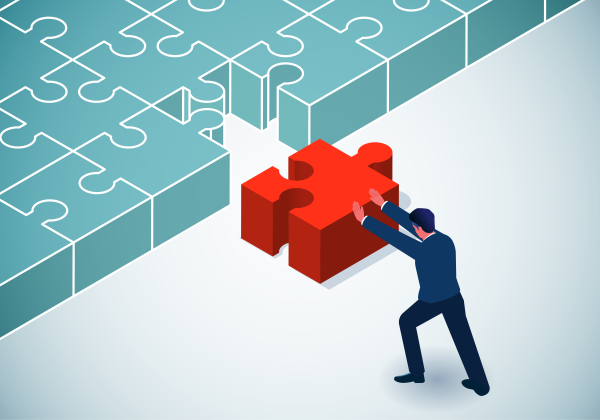ServiceMaster’s Innovation Overhaul
Quick Hits
The Challenge: Despite being a leader in many of its industry categories, ServiceMaster was struggling with dated technology and a risk-averse mindset that was hindering the customer experience.
The Plan: With the backing of company leadership, CIO Jamie Smith and his team launched a campaign to transform the organizational culture into one that embraced innovation and put the customer at the center of every decision.
The Execution: To drive the culture shift, Mr. Smith sought out quick wins that could build momentum, learned from leading digital native organizations and created a safe space for innovation to thrive.
The Results: More than two years into the transformation, ServiceMaster has seen improving employee retention rates, a rise in its Net Promoter Score and a 35 percent increase in online sales for one of its business units.
ServiceMaster was starting to feel its age.
Only a few years ago, the 88-year-old conglomerate—which owns a variety of residential and commercial services companies including Merry Maids, Terminix and American Home Shield (AHS)—was getting by with outdated technologies and tired processes. A multiyear effort to implement a new customer relationship management system had ended in failure. In-the-field technicians and salespeople were relying on flip phones and data scanners to communicate with clients. Online sales made up only a small percentage of the revenue draw for many of ServiceMaster’s various companies. And while the company was still a market leader in every area in which it competed, customer experience was suffering.
Complacency was rife—and the executive team knew change was necessary if ServiceMaster was going to compete with the likes of Amazon Home Services, Angie’s List and Google Thumbtack.
“Companies outside of our own were setting expectations for our customers,” says Jamie Smith, senior vice president and CIO of ServiceMaster, Memphis, Tennessee, USA. “It’s not the other bug companies of the world or the other maid companies that are driving customer expectations. It’s companies like Uber and Airbnb and Amazon.”
So two years ago—with strong backing from the company’s executive leadership—Mr. Smith and his team began a campaign to transform ServiceMaster into a tech-first organization with a lean startup mentality that put customer experience at the heart of every decision.
But the company’s organizational culture was plagued with change fatigue. “ServiceMaster has been through a lot of change, even in its most recent history,” says Mr. Smith. “There was a little bit of a survival mentality and an aversion to risk-taking.” So for the transformation to really take root, Mr. Smith and his team also had to build a culture that embraces innovation.
Build Momentum
Every move Mr. Smith and his team made had to be done with the goal of garnering employee buy-in and ridding the organization of what he calls the “middle management permafrost.” “That’s the middle layer that says, ‘This is the next flavor of the day. I’ll just wait it out and go back to doing what I was doing.’”
So Mr. Smith purposefully started with small, data-driven wins. “I know it’s said a lot,” he says. “But having very demonstrative wins is going to get you through that leap of faith when people question if this is the right way to do things.”
Up first was an overhaul of AHS’ website, which accounted for less than 15 percent of the business unit’s sales. “At the end of the day, you’re selling a piece of paper with a promise on it. You have to educate people on it, and online is a great space for doing that,” he says.
“It’s not the other bug companies of the world or the other maid companies that are driving customer expectations. It’s companies like Uber and Airbnb and Amazon.” —Jamie Smith, senior vice president and CIO, ServiceMaster
But the channel was weak because, as Mr. Smith says, it was an “average product for an average customer.” There was a poor mobile presence and only one path through the site: Each visitor received a basic, undifferentiated experience. And ultimately, there was a big pushback on whether or not AHS should be sold online. “I think there was a belief with the people that had been here for a long time that we need to go into the kitchen with a binder, lay it out, have a 30-minute sales discussion and talk through the best way to set up our products for customers,” says Mr. Smith. What became the biggest hurdle for him was simply proving that online sales were worthwhile.
To get everyone invested in developing the new customer journey, Mr. Smith embedded members of the business team with the tech teams and encouraged them to test various changes to the website to see what brought in customers. The result of this process is a website that now drives 50 percent of AHS customer interactions.
That success has bred excitement for change, he says. “When the company started seeing the AHS results and seeing what it could mean for other organizations across the larger conglomerate, other groups got on board, including Merry Maids and Terminix.”
Testing has become standard operating procedure for every one of ServiceMaster’s new digital customer initiatives. It is a mentality that is changing the approach for how decisions are made.
For example, during the creation of the AHS online customer portal, the team played with multiple variations of the contact button to test which one received the better response rate. The winner was a bright orange button that lay outside of the unit’s mostly red and blue color palette. “But it worked almost 15 percent better, so based on that, the button stayed orange,” Mr. Smith says. “We had to fight the brand team, but we could not treat this thing like a branding exercise or a brochure. It’s really about the way our customers interact with it. That mindset shift is really what did it for us.”
Innovation, Democratized
Any changes Mr. Smith and his team wrought were doomed without deep employee buy-in. To get people onboard and involved, Mr. Smith and his team had to foster an environment where ideas could be generated from the bottom up. ServiceMaster’s CEO helped by setting a new tone at the beginning of the transformation process. He put forth a list of values the organization would embrace—including intelligent risk-taking.
“Who and what we celebrate says a lot about who we are.” —Jamie Smith
To give that intelligent risk-taking a physical space to manifest, earlier this year ServiceMaster launched an innovation center—dubbed Ground Floor—in its still-to-be-completed headquarters in Memphis. The space serves as the home base for some of the city’s promising startups and helps to drive inspiration for ServiceMaster employees. “We’re going to have some of our own internal people working [in the innovation center] as well,” Mr. Smith says. “[We want them] to see and remember what it’s like to work in a startup, to feel that energy and have that serendipitous collision of ideas.”
And ideas the company has been “kicking around for a long time”—such as AHS going beyond the home warranty space to retail—can be incubated at the innovation center, Mr. Smith says.
“Those types of ideas need a place to be nurtured and people to focus on them as their only thing. It’s hard to do that in the normal course of business.” Mr. Smith and his team have also launched a series of hackathons, where any employee can submit an idea and work with other team members to test it.
The company’s most recent hackathon produced four new ideas that were presented and approved by the leadership team for further development at the innovation center. Teams at the center are now working up prototypes. “We’re ready to give them a round of funding, just like you would a startup, because they’re on to something,” says Mr. Smith.
Learn From the Best
ServiceMaster is comfortable leveraging good ideas from the broader business world for its organizational transformation. The company did not invent hackathons, but it is using the approach to its advantage. Similarly, Mr. Smith made a point of talking to and learning from digital native companies such as Uber, Netflix, Spotify and Amazon.

For example, ServiceMaster has followed in Uber’s footsteps when it comes to customer communication and feedback. The company set up a “Where’s My Tech” mobile notification system, and asks customers to rate technicians on a one- to five-star scale as soon as an appointment ends.
“We used to survey a couple of days later and nobody would respond,” Mr. Smith says. “When it’s fresh in your mind, more people respond. Because of real-time architecture, we have the ability to reach out almost immediately [after] a bad experience and try to save it. We find out the experiences we save actually end up trending higher than the experiences that went well the first time.”
The approach has even been a boon to an all-important customer metric: The Net Promoter Score for Terminix, for example, has seen a significant increase since the feature was launched.
Room to Fail
An executive pushing a change agenda to overhaul the organization’s processes and increase its innovation appetite can be a scary prospect for many employees. To counter that thinking, the team began celebrating failures right alongside success stories.
“Failures are great because we learn from them. But we need to make them as small as possible and we need to learn from them as quickly as possible [in order to] pivot to the next thing,” he says. “Who and what we celebrate says a lot about who we are.”
And while Mr. Smith says there have been no spectacular failures thus far, there have been some missteps that jump out as prime learning experiences.
“As an example, I tried to increase our team deployments to 10 per day,” he says. “That was probably too much. For our technicians that don’t want things to change that much, you have to retrain them in some ways with every change. You don’t get a new Bank of America app 10 times per day and have to relearn how to use it. We need the ability to [make multiple updates], but we pushed it too far and we outran our change tolerance.”
That continuous learning is now built into the company’s culture. Every two weeks teams participate in a retrospective to review what has gone wrong and what they are going to focus on doing better next time. It’s that kind of change that Mr. Smith is most proud of.
“You’re always building tomorrow’s legacy system today,” he says. “Whatever you’re going to do doesn’t last that long in the digital space. But what is going to last is the culture that we’ve created and this ability to move fast, fail fast, be agile and learn. That’s going to far outlive any app that we put on the phone. And that, to me, is most significant. We’re building the team to win in an uncertain world and building the team for speed, and that’s what’s going to keep us going.”



